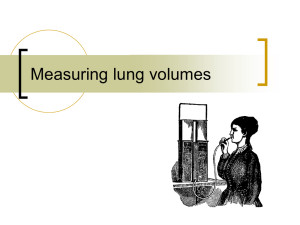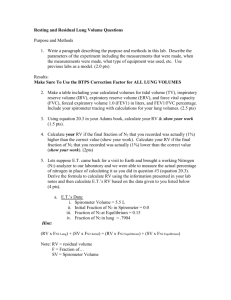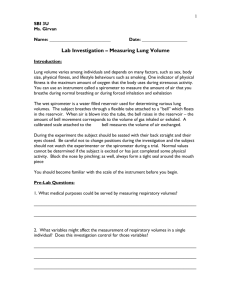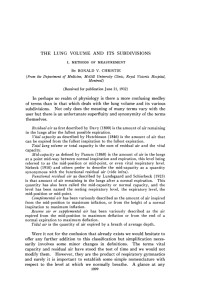LUNG VOLUMES LABORATORY ACTIVITY
advertisement
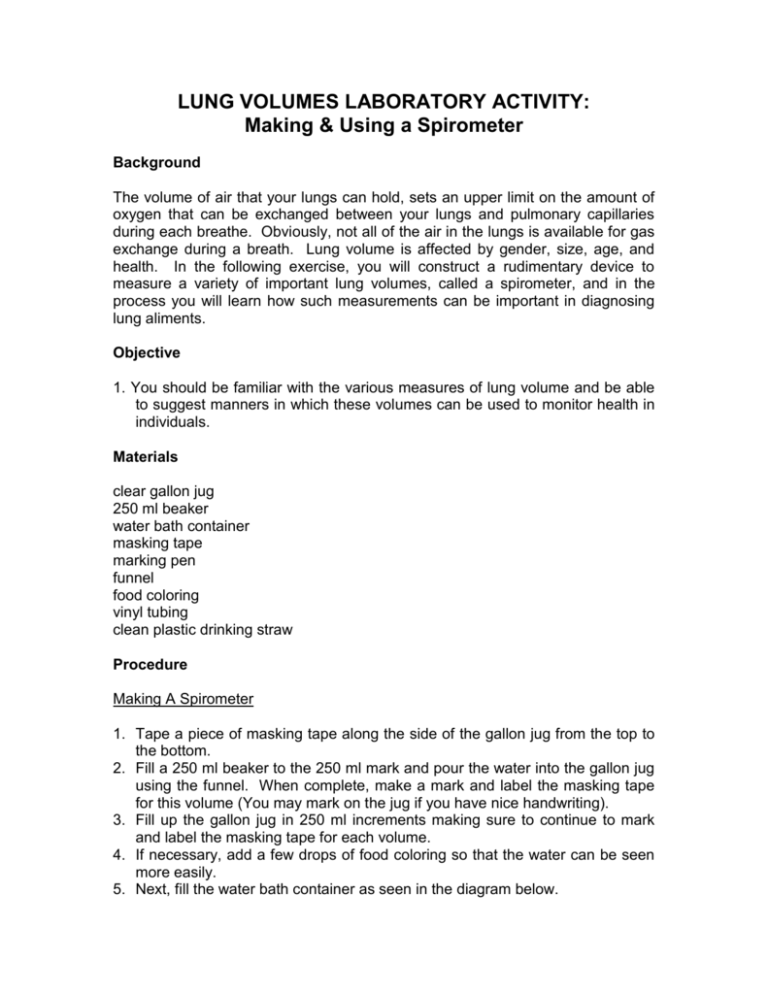
LUNG VOLUMES LABORATORY ACTIVITY: Making & Using a Spirometer Background The volume of air that your lungs can hold, sets an upper limit on the amount of oxygen that can be exchanged between your lungs and pulmonary capillaries during each breathe. Obviously, not all of the air in the lungs is available for gas exchange during a breath. Lung volume is affected by gender, size, age, and health. In the following exercise, you will construct a rudimentary device to measure a variety of important lung volumes, called a spirometer, and in the process you will learn how such measurements can be important in diagnosing lung aliments. Objective 1. You should be familiar with the various measures of lung volume and be able to suggest manners in which these volumes can be used to monitor health in individuals. Materials clear gallon jug 250 ml beaker water bath container masking tape marking pen funnel food coloring vinyl tubing clean plastic drinking straw Procedure Making A Spirometer 1. Tape a piece of masking tape along the side of the gallon jug from the top to the bottom. 2. Fill a 250 ml beaker to the 250 ml mark and pour the water into the gallon jug using the funnel. When complete, make a mark and label the masking tape for this volume (You may mark on the jug if you have nice handwriting). 3. Fill up the gallon jug in 250 ml increments making sure to continue to mark and label the masking tape for each volume. 4. If necessary, add a few drops of food coloring so that the water can be seen more easily. 5. Next, fill the water bath container as seen in the diagram below. 6. After the water bath is prepared, place the gallon jug upside down into the water bath by holding your hand over the mouth of the jug while transferring it into the water. Hold the jug upright so that it doesn’t tip over. 7. Cut the vinyl tubing to a length that will allow it to extend from a potential subject, through the water, and into the gallon jug. Preparing to Use the Spirometer 1. Find a graph of the variety of lung capacity measurements in your textbook. Copy and label the graph in the first question, using the following terms (you will have to reason to figure out the location for some of these terms). Terms include Residual Volume, Tidal Volume, Inspiratory Reserve Volume, Expiratory Reserve Volume, Vital Capacity, and Total Lung Capacity. 2. After you have determined the various lung capacities, determine a method for measuring each using your spirometer. Record your methods in the second question. 3. Then, determine a manner in which these volumes can be used to determine the Vital capacity and record your equation in the third question. Using the Spirometer 1. Finally, using the methods that you have developed, measure the various lung volumes for each of your group members. Record this data in the table provided the forth question. Bibliography Modified from “Catch Your Breath” lab from the Science Museum of Minnesota http://www.smm.org/heart/lessons/lesson9.htm LUNG VOLUMES LABORATORY ACTIVITY: Making & Using a Spirometer Name: __________________________ Spirometer Preparation 1. Graph of lung volumes 2. Method for lung volume measurements Tidal Capacity (TV) Inspiratory Reserve Volume (IRV) Expiratory Reserve Volume (ERV) 3. Vital Capacity Calculation Spirometer Use 3. Data Table Lung Volumes TV IRV ERV VC Group Subjects 1 2 3 Spirometer Analysis & Application 4. Given that the average adult individual has a vital capacity of 4500 ml (females may range as low as 3000ml while males may range as high as 6500 ml), how do the measurements of your group members compare? 5. How much air do you inhale into your lungs every minute? Show your work. 6. Based on the values for the partial pressure for oxygen in dry inhaled air and moist exhaled air in your text and your knowledge of how to calculate partial pressures, determine the percentage of atmospheric oxygen actually enters the blood stream. Show your work. 7. Based on the two previous calculations, determine the amount of oxygen that enters your lungs in a minute. Show your work. 8. How might the lung volume(s) of an athlete differ from an average person? Why? 9. How might the lung volume(s) of a person suffering from emphysema differ from an average person? Why?

